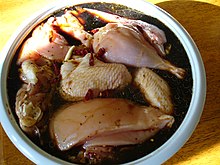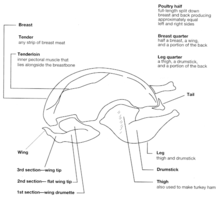Chicken as food: Difference between revisions
Reverted 1 edit by Harristhecavaliers; Rvt promotional site. (TW) |
i had put a recipes link on how to make chicken cuisines |
||
| Line 78: | Line 78: | ||
== External links == |
== External links == |
||
* [http://www.yummy-chicken-recipes.com Chicken Recipes Collection Website] |
|||
* [http://www.primetamil.com/cook.php Chilly chicken Recipe (in Tamil)] |
* [http://www.primetamil.com/cook.php Chilly chicken Recipe (in Tamil)] |
||
* [http://www.foodnetwork.com/food/mh_chicken/text/ Foodnetwork.com page on use of chicken in cooking] |
* [http://www.foodnetwork.com/food/mh_chicken/text/ Foodnetwork.com page on use of chicken in cooking] |
||
Revision as of 03:31, 12 January 2009
The examples and perspective in this article may not represent a worldwide view of the subject. |
| Nutritional value per 100 g (3.5 oz) | |
|---|---|
| Energy | 900 kJ (220 kcal) |
0 g | |
15 g | |
| Saturated | 4.3 g |
| Monounsaturated | 6.2 g |
| Polyunsaturated | 3.2 g source_usda = 1 |
19 g | |
| Vitamins | Quantity %DV† |
| Vitamin A equiv. | 5% 41 μg |
| Pantothenic acid (B5) | 18% 0.9 mg |
| Minerals | Quantity %DV† |
| Iron | 5% 0.9 mg |
| Sodium | 3% 70 mg |
| Other constituents | Quantity |
| Water | 66 g |
Not including 37% bones. Excluding 13% skin and loose fat reduces fat content to 6%. | |
| †Percentages estimated using US recommendations for adults,[1] except for potassium, which is estimated based on expert recommendation from the National Academies.[2] | |
Chicken is the meat derived from the chicken. It is the most common type of poultry in the world, and is frequently prepared as food in a large number of ways.
History
The modern chicken is a descendant of Red Junglefowl hybrids with the Grey Junglefowl first raised thousands of years ago in the northern parts of the Indian subcontinent.[3]
Chicken as a meat has been depicted in Babylonian carvings from around 600 BC.[4] Chicken was one of the most common meats available in the Middle Ages. It was widely believed to be easily digested and considered to be one of the most neutral foodstuffs. It was eaten over most of the Eastern hemisphere and a number of different kinds of chicken such as capons, pullets and hens were eaten. It was one of the basic ingredients in the so-called white dish, a stew usually consisting of chicken and fried onions cooked in milk and seasoned with spices and sugar.
U.S. chicken consumption increased during World War II due to a shortage of beef and pork.[5] In Europe, consumption of chicken overtook that of beef and veal in 1996, linked to consumer awareness of Bovine spongiform encephalopathy or B.S.E.[6]
Breeding
Modern varieties of chicken such as the Cornish Cross, are bred specifically for meat production, with an emphasis placed on the ratio of feed to meat produced by the animal. The most common breeds of chicken consumed in the US are Cornish and White Rock.[7]
Chickens raised specifically for meat are called broilers. In the United States, broilers are typically butchered at a young age. Modern Cornish Cross hybrids, for example, are butchered as early as 8 weeks for fryers and 12 weeks for roasting birds.
Capons (castrated cocks) produce more and fattier meat. For this reason, they are considered a delicacy and were particularly popular in the Middle Ages.
Edible components

Typically, the muscle tissue (breast, legs, thigh, etc), livers, hearts, and gizzard are processed for food. Chicken feet are commonly eaten, especially in French and Chinese cuisine. Chicken wings refers to a serving of the wing sections of a chicken.
Chicken eggs are commonly eaten and unlaid eggs removed from slaughtered hens can also be eaten.
Marketing & Sales
Whole chickens are marketed as fryers, broilers, and roasters. Fryers are the smallest size, and the most common as chicken reach this size quickly. Most dismembered packaged chicken would be sold whole as fryers. Broilers are larger than fryers. They are typically sold whole. Roasters, or roasting hens, are the largest chickens sold and are typically more expensive. They are meant to be prepared in a method similar to a turkey or roast.
Chicken is also sold in dismembered pieces. Pieces may include quarters, or fourths of the chicken. A chicken is typically cut into two leg quarters and two breast quarters. Each quarter contains two of the commonly available pieces of chicken. A leg quarter contains the thigh, drumstick and a portion of the back; a leg has the back portion removed. A breast quarter contains the breast, wing and portion of the back; a breast has the back portion and wing removed. Pieces may be sold in packages of all of the same pieces, or in combination packages. Whole chicken cut up refers to either the entire bird cut into 8 quarters (8-piece cut); or sometimes without the back. A 9-piece cut (usually for fast food restaurants) has the tip of the breast cut off before splitting. Pick of the Chicken, or similar titles, refers to a package with only some of the chicken pieces. Typically the breasts, thighs, and legs without wings or back. Thighs and breasts are sold boneless and/or skinless. Dark meat (legs, drumsticks and thighs) pieces are typically cheaper than white meat pieces. Chicken livers and/or gizzards are commonly available packaged separately.
Other parts of the chicken, such as the neck, feet, combs, etc. are not widely available except in countries where they are in demand, or in cities that cater to ethnic groups who favor these parts.
Cooking


Raw chicken can be frozen for up to two years without significant changes in flavor or texture and is typically eaten cooked--as when raw it often contains salmonella; raw or rare chicken dishes appear in Ethiopian cuisine and Chinese cuisine[citation needed].
Chicken can be cooked in innumerable ways; it can be made into sausages, put in salads, grilled, breaded and deep-fried, or used in various curries. There is significant variation in cooking methods amongst cultures; historically common methods include roasting, baking and frying. Today, chickens are also cooked by deep frying and prepared as fast food as Fried Chicken, chicken nuggets or Buffalo wings.
Chickens often come with labels such as "roaster", which suggest a method of cooking based on the type of chicken. While these labels are only suggestions, ones labeled for stew often do not do well when cooked with other methods.[8]
Some chicken breast cuts and processed chicken breast products include the moniker "with Rib Meat." This is a misnomer, as it is the small piece of white meat that overlays the scapula, and is removed with the breast meat. The breast is cut from the chicken and sold as a solid cut, while the leftover breast and true rib meat is stripped from the bone through mechanical separation for use in chicken franks, for example. Breast meat is often sliced thinly and marketed as chicken slices, an easy filling for sandwiches. Often, the tenderloin (pectoralis minor) is marketed separately from the breast (pectoralis major). In the US, "tenders" can be either tenderloins or strips cut from the breast.
While chicken bones are not edible, they can be simmered with vegetables and herbs for hours or even days to make chicken stock.
In Asian countries it is possible to buy bones alone as they are very popular for making chicken soups, which are said to be healthy. In Australia the rib cages and backs of chickens after the other cuts have been removed are frequently sold cheaply in supermarket delicatessen sections as either "chicken frames" or "chicken carcasses" and are purchased for soup or stock purposes.
Arsenic
Factory farmed chickens are routinely administered with 4-Hydroxy-3-nitrobenzenearsonic acid, an organoarsenic compound which decomposes into inorganic arsenic compounds in the flesh of chickens, and in their feces, which is often used as a fertilizer.[9] A Consumer Reports study in 2004 reported finding "no detectable arsenic in our samples of muscle" but found "A few of our chicken-liver samples has an amount that according to EPA standards could cause neurological problems in a child who ate 2 ounces of cooked liver per week or in an adult who ate 5.5 ounces per week." However, the Food and Drug Administration (FDA) is the organization responsible for the regulation of feeds and most foods in America, and all samples tested were "far less than the... amount allowed in a food product."[10]
References
- ^ United States Food and Drug Administration (2024). "Daily Value on the Nutrition and Supplement Facts Labels". FDA. Archived from the original on 2024-03-27. Retrieved 2024-03-28.
- ^ National Academies of Sciences, Engineering, and Medicine; Health and Medicine Division; Food and Nutrition Board; Committee to Review the Dietary Reference Intakes for Sodium and Potassium (2019). Oria, Maria; Harrison, Meghan; Stallings, Virginia A. (eds.). Dietary Reference Intakes for Sodium and Potassium. The National Academies Collection: Reports funded by National Institutes of Health. Washington, DC: National Academies Press (US). ISBN 978-0-309-48834-1. PMID 30844154. Archived from the original on 2024-05-09. Retrieved 2024-06-21.
- ^ Eriksson J, Larson G, Gunnarsson U, Bed'hom B, Tixier-Boichard M, et al. (2008) Identification of the Yellow Skin Gene Reveals a Hybrid Origin of the Domestic Chicken. PLoS Genet January 23, 2008 [1].
- ^ http://www.poultrymad.co.uk/chicken-facts/index.html Chicken facts and origins at Poultrymad
- ^ Poultry Farming, The History Channel. March 2 2007.
- ^ BBC survey another blow against UK chicken
- ^ Focus On: Chicken, USDA. March 2, 2007.
- ^ How to Buy: 5 Things to Keep in Mind, Food Network. March 2 2007.
- ^ "Arsenic In Chicken Production", Chemical & Engineering News, April 9, 2007, Volume 85, Number 15, pages 34-35 [2]
- ^ http://www.consumerreports.org/cro/food/animal-feed-and-the-food-supply-105/chicken-arsenic-and-antibiotics/index.htm
